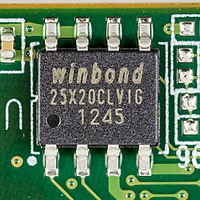 | |
| Abbreviation | UEFI |
|---|---|
| Status | Published |
| Year started | 2006[a] |
| Latest version | 2.10 August 29, 2022 |
| Organization | UEFI Forum |
| Related standards | ACPI, UEFI Platform Initialization |
| Predecessor | BIOS on IBM PC compatible computers[b] |
| Domain | Firmware |
| Website | uefi |
Unified Extensible Firmware Interface (UEFI, /ˈjuːɪfaɪ/ or as an acronym)[c] is a specification for the firmware architecture of a computing platform. When a computer is powered on, the UEFI-implementation is typically the first that runs, before starting the operating system. Examples include AMI Aptio, Phoenix SecureCore, TianoCore EDK II, InsydeH2O.
UEFI replaces the BIOS which was present in the boot ROM of all personal computers that are IBM PC compatible,[4][5] although it can provide backwards compatibility with the BIOS using CSM booting. Contrary to its predecessor BIOS which is a de facto standard originally created by IBM as proprietary software, UEFI is an open standard maintained by an industry consortium.
Intel developed the original Extensible Firmware Interface (EFI) specification. The last Intel version of EFI was 1.10 released in 2005. Subsequent versions have been developed as UEFI by the Unified EFI Forum.
UEFI is independent of platform and programming language, but C is used for the reference implementation TianoCore EDKII.
Cite error: There are <ref group=lower-alpha> tags or {{efn}} templates on this page, but the references will not show without a {{reflist|group=lower-alpha}} template or {{notelist}} template (see the help page).
- ^ "Documentation - Winbond".
- ^ "Microsoft Surface Laptop 7 (13.8-inch) Chip ID". 22 June 2024.
- ^ Zimmer, Vincent; Rothman, Michael; Marisetty, Suresh (2017). Beyond BIOS: Developing with the Unified Extensible Firmware Interface, Third Edition. Walter de Gruyter GmbH & Co KG. ISBN 978-1-5015-0569-0.
- ^ Kinney, Michael (1 September 2000). "Solving BIOS Boot Issues with EFI" (PDF). pp. 47–50. Archived from the original (PDF) on 23 January 2007. Retrieved 14 September 2010.
- ^ Cite error: The named reference
ElReg1was invoked but never defined (see the help page).

